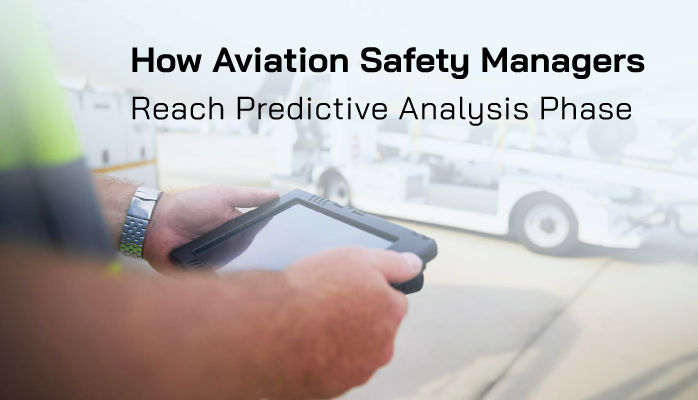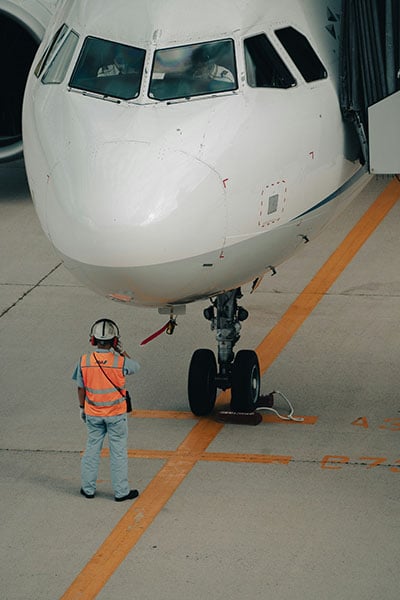Problems With Aviation Safety Departments vs Operations

Aviation service providers are in business to provide a service. While some providers are government-funded, most offer their services to achieve common strategic business objectives, namely:
- Increased market share;
- Increased financial or physical resources; or
- Innovation to create additional products or services.
Every aviation service provider works with finite resources to deliver their services to align with their business objectives. These operators assign budgets to divisions or departments to perform their mission.
In most cases, there is an implicit (and often explicit) accountability requirement to ensure assigned funds are properly used.
Have you ever wondered why your safety budget is minimal or next to nonexistent?
How to Profit From Aviation Safety?
How do you move your aviation safety management system (SMS) from reactive risk management to the idealistic predictive analysis phase?
What is the predictive analysis phase of an aviation SMS? What does it mean to you? Do you believe that your company will have a crystal ball and keep all accidents from happening once you reach the SMS predictive analysis phase?
How do you move your safety department into your company's list of visible profit drivers?
Related Predictive Analysis in Aviation SMS Articles
- Difference Between Reactive, Predictive and Proactive Risk Management in Aviation SMS
- How to Practice Reactive, Proactive, and Predictive Risk Management in Aviation SMS
- 3 Ways to Practice Predictive Risk Management
Budgets Are Allocated to Visible Profit Drivers

Divisions or departments with the largest budgets visibly affect the bottom line. I repeat: departments generating revenue visibly affect an aviation service provider's ability to provide services to stakeholders.
Visible profit drivers at airlines and airports are:
- Flight operations;
- Ground handling;
- Maintenance;
- Facilities;
- Sales and Marketing; and
- Administration.
The safety department is not on this list of profit drivers. Aviation safety managers must work very hard to visibly demonstrate value. You may argue that "Administration" is not a direct profit driver, but all businesses need Administration to keep the lights on.
Safety Departments Are Not Visible Profit Drivers
The safety department is very similar to the security department in that it is difficult to measure and show tangible value. To management, safety and security departments are similar to consumer insurance. Most of us are familiar with insurance as a consumer. You probably purchase one of these types:
- Home;
- Auto;
- Medical; or
- Property.
If you are like me, I don't like to have too much insurance. I'd rather put my money to work in other ways.
Since I don't like to have too much insurance, it makes sense that management doesn't want to invest too heavily in safety. Management wants to give the appearance that "safety is first," but we all know that the bottom line comes first.
Management is practical, just like you. Can your household survive without insurance for a term, such as six months or a year? Probably so. Our household goes years without using insurance. Imagine what you could do with the money.
When we opt to use our money to make more money, then we must accept the risk of a hazard manifesting itself and suffering the consequences. We hope that we don't suffer a catastrophe when we choose to operate with higher risk.
Management often thinks the same way because they are logical and have limited budgets at their disposal. They would prefer to allocate funds to the visible profit drivers and hope for the best, just as you do when you opt to not pay for your medical insurance for a year.
Have You Read
- Why Money Is More Important Than Safety in Aviation
- Tips to Increase Aviation SMS Budgets - for Safety Managers
- How to Earn Top Management Support for Aviation SMS
Great Job Today, Safety Manager!

Does your boss come up to you and say, "Great work today. You saved us from an accident today?"
Or
"Good job. We had no events that cost us money today."
This is highly unlikely. Yet when there is a safety event, you may feel all eyes are directed to the "safety manager." Why wasn't this event predicted? Why were we not more aware of this potential risk?
We are unable to see into the future. Yet we can see into the past and predict an event.
Accidents, Incidents, and Irregularities Lead to Predictive Analysis
Major events are most often preceded by many smaller events, which by themselves may casually appear inconsequential. The Heinrich-Bird accident pyramid visually illustrates that for every 600 close calls in your organization, there will be ten minor accidents and one major accident.
Aviation safety managers around the world face four common challenges:
- Collect enough data to make predictions;
- Getting employees to report close calls and "potential" hazards;
- Categorize collected data to prepare for predictive analysis activities; and
- Having access to tools to easily and routinely conduct predictive analysis reports.
The first two points are related to company size and corporate safety culture. Smaller companies don't have many employees to report hazards or potential hazards. Simple enough. However, an aviation SMS' hazard reporting culture must be continually stimulated to urge employees to participate in the SMS and report those 600 close calls.
As your safety team works on those 600 close calls, your aviation SMS will strengthen your ability to withstand the effects of minor and major accidents. In short, your risk mitigation strategies will improve ineffectiveness. The point to really stress is that your employees need to be actively engaged in the SMS to help ensure your company is prepared to deal with that single event with the fatality or major accident. Hazard reporting culture can be improved in 80% of all aviation service providers, regardless of your industry segment.
Related Hazard Reporting Culture Articles
- Indicators of Good Hazard Reporting Culture
- How Aviation Safety Managers Can Improve Safety Reporting Cultures
- Essential KPIs for Poor Hazard Reporting Cultures in Aviation SMS - With Free KPI Resources
Where Does Predictive Analysis Data Come From?

As I alluded to above, most employees will not report an issue unless it is required. For the sake of discussion, let's define an issue as an:
- Accident;
- Incident;
- Irregularity (also known as "other safety occurrence"); or
- Hazard (real or potential).
Organizational safety issues must be reported, categorized, and analyzed in order to predict future events. When issues are not reported, the safety management process fails.
As I keep saying, most employees won't report an issue unless it is required. Furthermore, most employees will not report issues even
- When it is required; and
- When they believe nobody is watching; and
- There is no enforcement; or
- When there are no repercussions for not reporting.
Getting Employees to Report Aviation Safety Issues
There are many strategies to encourage hazard reporting to acquire enough data to regularly engage in predictive analytical procedures. They may include:
- Safety promotional posters around the workplace;
- Safety newsletters continually offering encouragement;
- Special announcements on how safety reports averted a potential disaster (or major problem);
- Well-crafted safety policies outlining employee responsibilities to report;
- Job descriptions including safety duties and responsibilities;
- Motivational announcements from the accountable executive;
- Regular safety meetings that reinforce hazard reporting; and
- Visible support from managers and supervisors to the safety process.
Categorizing Reported Issues for Future Predictive Data Analysis
Let us now assume employee issue-reporting has increased or you already enjoy a healthy reporting culture. Safety managers will need to be able to easily classify issues according to an industry-accepted schema. Since every company is a bit different, your schema may include common industry elements including some others that are particular to your industry, such as key business or safety performance indicators (KPIs or SPIs).
You can have the best safety reporting culture in the world, but your aviation risk management program will lack value unless you can quickly categorize your issues and easily generate reports. If it is not easy, you will either:
- continue to endure a painstaking data analysis process; or
- you'll give up or do a very hasty, insincere job analyzing the data.
Sustainable risk management processes are processes that are repeatable and within the capabilities of the assigned safety personnel. When your data analysis activity is not easy to repeat, your chances decrease markedly for making sound risk management decisions based on your predictive analytics. Sound decision-making that reduces organizational risk is the objective of your predictive analysis.
Spreadsheets are not the proper technology for classifying safety data when you wish to progress to the predictive analysis phase. Managing spreadsheet data for reported safety issues is cumbersome and not sustainable. An SMS database is required.
Several low-cost, commercially available SMS database solutions make hazard reporting and risk management a sustainable process, regardless of whether you are managing ten issues per month, or 1000. I recommend a complete system for managing all required SMS processes instead of adopting another point solution that will address only a particular aspect of aviation SMS. It makes good business sense that all your SMS data is stored and easily accessible from a single SMS database. Using an SMS database is a sustainable solution if you aspire to successfully benefit by reducing losses and improving safety from your collected safety data.
Related Aviation SMS Database Articles
- What Is an Aviation Safety Database
- How to Choose the Best Aviation Safety Database Software
- 3 Things to Know Before Buying Aviation SMS Database
Analyzing Data to Predict Events and Safety Related Costs

Safety managers are motivated, results-driven professionals. They work hard and many of their activities are obscured from the rest of the organization. Analyzing data is the most complex task in reaching the predictive analysis phase of your SMS.
To predict the probability and potential severity of a future event, safety managers spend weeks and months:
- Collecting data,
- Creating elaborate spreadsheets and
- Analyzing the data.
The disappointing reality is that this task is often too brutal to bear more than once for average aviation safety managers. The average aviation safety manager is kept busy putting out fires and managing the aviation SMS requirements. Unless the aviation safety manager has proper safety data analysis tools, the predictive analysis ideal will never bear fruit.
For a deeper treatment of predictive analysis, you may want to read "Safety Management Systems in Aviation" by Alan Stolzer, et.al.
As you analyze your collected safety data, you will be looking for trends that alert management that a particular area of operations requires additional risk management strategies to mitigate risk and reduce losses. In short, you are looking for a pattern based on your historical safety performance.
Related Aviation SMS Trend Analysis Articles
- Aviation Safety Managers' Best Friend - Trending Charts
- How to Prepare Data for Trend Analysis in Risk Management Programs
- Six Steps How to Perform Trend Analysis in Aviation SMS
Final Thoughts on Safety Managers at the Predictive Analysis Phase
Modern aviation safety management principles pull aviation service providers from reactive risk management to proactive risk management. If an operator is ever to reach this final goal of proactive risk management with predictive capabilities, safety managers will need:
- Healthy reporting cultures;
- Sophisticated, modern aviation SMS tools to quickly and efficiently manage increasing numbers of reported issues; and
- Good software tools to easily conduct regular predictive analysis activities.
Many claims that aviation SMS offer many benefits to aviation service providers. Your company will not benefit fully from your efforts until you reach the predictive analysis phase. Oddly enough, your safety department will also start enjoying larger budgets because the safety department will become a visible profit driver.
Good luck.
See how aviation SMS tools multiply the effect of your safety team!
An integrated safety-quality assurance solution allows aviation service providers to use one system to manage both safety and quality elements.
Last updated March 2025.






